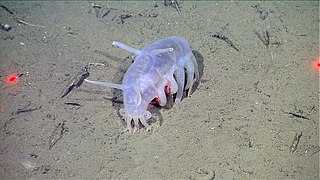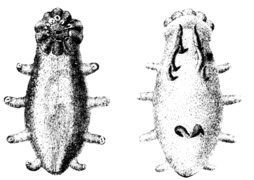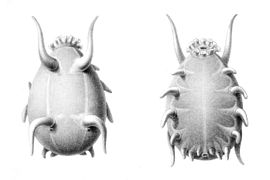
Sea cucumbers are echinoderms from the class Holothuroidea. They are marine animals with a leathery skin and an elongated body containing a single, branched gonad. Sea cucumbers are found on the sea floor worldwide. The number of holothurian species worldwide is about 1,717, with the greatest number being in the Asia-Pacific region. Many of these are gathered for human consumption and some species are cultivated in aquaculture systems. The harvested product is variously referred to as trepang, namako, bêche-de-mer, or balate. Sea cucumbers serve a useful role in the marine ecosystem as they help recycle nutrients, breaking down detritus and other organic matter, after which bacteria can continue the decomposition process.

Enypniastes is a genus of deep-sea sea cucumber. It is monotypic, being represented by the single species Enypniastes eximia. Due to its unique appearance, the species has been dubbed the headless chicken fish, headless chicken monster, and the Spanish dancer. It is also known as the swimming sea cucumber, and some are called the pink see-through fantasia.

Golfingiidae is a family of peanut worms.

Golfingiida is an order of peanut worms. The tentacles form a circle around the mouth whereas those of the sister taxon, Phascolosomatidea, are only found above the mouth. Most species burrow in the substrate but some live in the empty shells of gastropods. It is the only order in the monotypic class Sipunculidea and contains the following families:

Psychropotes is a genus of sea cucumbers in the family Psychropotidae. The members of this genus possess the ability to swim, although this is only facultative.
Onchnesoma is one of the two genera that constitute the family Phascolionidae of Phylum Sipuncula, described by Koren and Danielssen established in 1873 as the type species to Onchnesoma steenstrupii.
Amperima rosea is a species of sea cucumber in the family Elpidiidae. It is found on the seabed at abyssal depths of 4,000 m (2.5 mi) or more. Around 1996, its numbers in the Porcupine Abyssal Plain in the northeastern Atlantic increased dramatically from a few individuals per hectare to over six thousand per hectare, a phenomenon that became known as the "Amperima event".
Elpidia is a genus of deep-sea sea cucumbers. Members are characterised by their rod-shaped spicules which each have two pairs of obliquely-placed horizontal arms and two vertical apophyses. There is a high degree of endemism in this genus with different species occupying different deep sea basins or regions.
Elpidia minutissima is a species of deep-sea swimming sea cucumber in the family Elpidiidae. It is a detritivore and is found in the northern Pacific Ocean.
Peniagone is a genus of deep-sea sea cucumbers in the family Elpidiidae. Peniagone wyvillii is the type species.
Peniagone vitrea is a species of deep-sea swimming sea cucumber in the family Elpidiidae. It is a detritivore and is found in the northern Pacific Ocean at abyssal depths. It was first described by the Swedish zoologist Hjalmar Théel in 1879, being one of the many deep sea animals discovered during the Challenger expedition of 1872–1876.

Johan Hjalmar Théel was a Swedish zoologist and university professor.
Ellipinion is a genus of deep-sea sea cucumbers in the family Elpidiidae. It was first described by the French marine biologist Edgard Hérouard in 1923.

Elpidia glacialis is a species of sea cucumber in the family Elpidiidae. It is found at abyssal depths in the Arctic Ocean, the Barents Sea, the Kara Sea and the north Atlantic Ocean. It was first described in 1876 by the Swedish zoologist Johan Hjalmar Théel after he had collected specimens while accompanying the explorer Adolf Erik Nordenskiöld on an expedition attempting to find the Northeast Passage.
Myriotrochidae is a family of sea cucumbers.

Scotoplanes globosa, commonly known as the sea pig, is a species of sea cucumber that lives in the deep sea. It was first described by Hjalmar Théel, a Swedish scientist. Scotoplanes globosa, along with numerous other sea cucumbers were discovered by Théel during an expedition on HMS Challenger between the years of 1873-1876. Scotoplanes globosa was officially described in 1882, 6 to 9 years after its first sighting. Scotoplanes globosa is most closely related to the genus Peniagone.

Psolus is a genus of sea cucumbers in the family Psolidae, marine animals with long bodies, leathery skins and tentacles, that inhabit the sea bed.

Psychropotidae is a family of deep-sea swimming sea cucumbers. The geographic range of some psychropotids is very extensive at abyssal depths, whereas other species are found within more restricted ranges.

Benthodytes is a genus of sea cucumbers in the family Psychropotidae.

Mesothuria is a genus of sea cucumbers belonging to the family Synallactidae. The genus has a cosmopolitan distribution.














